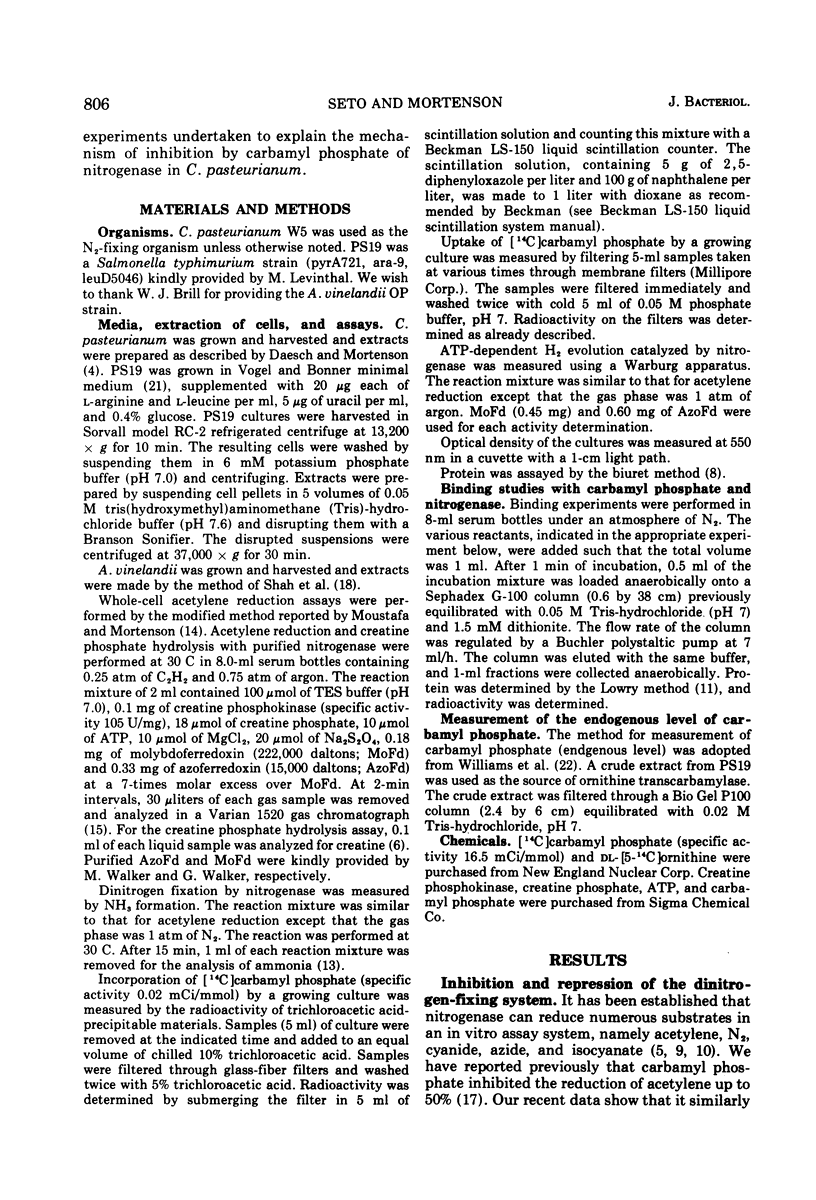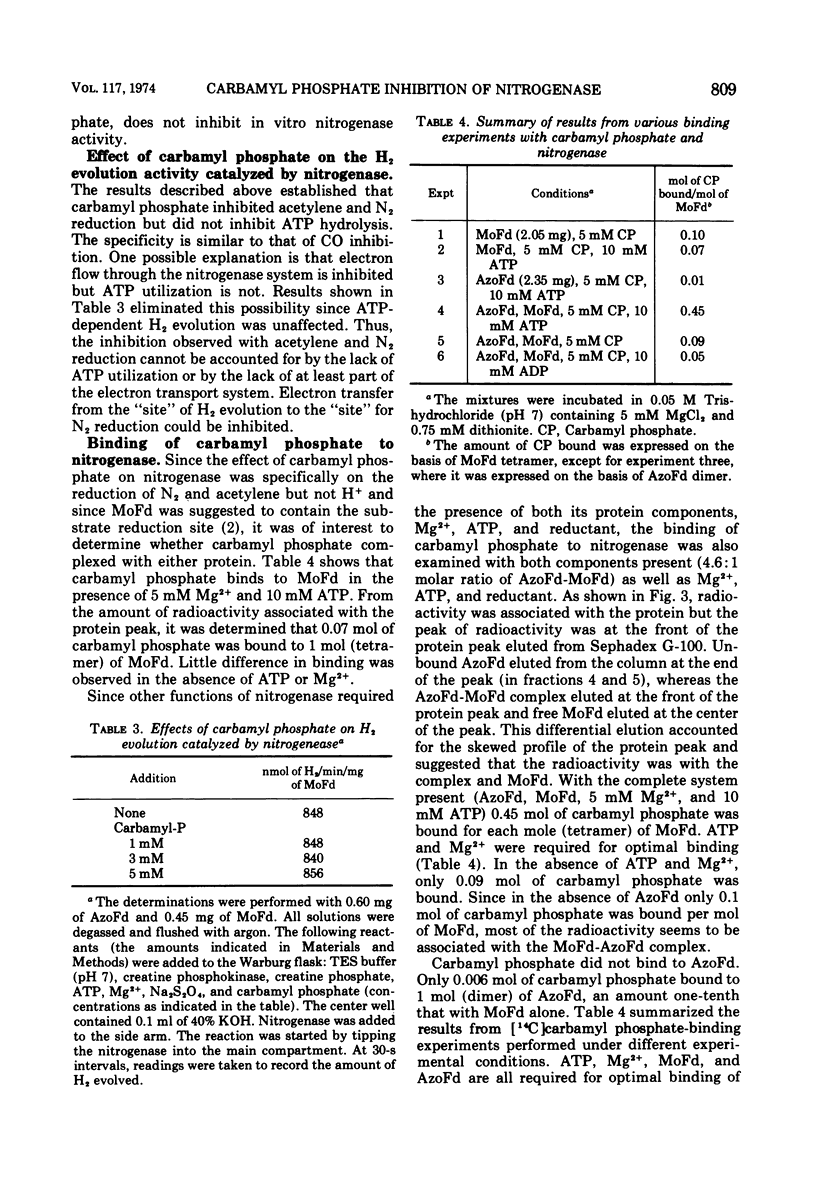Abstract
Carbamyl phosphate caused a maximal inhibition of 50% of the in vitro nitrogenase activity measured by acetylene reduction and dinitrogen reduction. The addition of 1 mM carbamyl phosphate to a N2-fixing culture caused a rapid decrease of 30% of the acetylene reduction activity and also repression of nitrogenase biosynthesis. However, carbamyl phosphate had no effect on the reductant-dependent adenosine triphosphate hydrolysis and H2 evolution reactions catalyzed by nitrogenase. Studies on the binding of carbamyl phosphate to nitrogenase and each of its two components (azoferredoxin and molybdoferredoxin) indicated that optimal binding was obtained only in the presence of an operating nitrogenase system. Moreover, the binding seemed to be on the molybdoferredoxin component rather than azoferredoxin. From a Scatchard plot and a reciprocal plot of the data, the values of n = 2 and dissociation constant (K) of approximately 5 × 10−5 M were obtained. The value for the dissociation constant was of the same order of magnitude as the endogenous level of carbamyl phosphate in a N2-fixing cell. The carbamyl phosphate pool in NH3-grown cells was twice that of N2-fixing cells.
Full text
PDF







Selected References
These references are in PubMed. This may not be the complete list of references from this article.
- ALLEN C. M., Jr, JONES M. E. DECOMPOSITION OF CARBAMYLPHOSPHATE IN AQUEOUS SOLUTIONS. Biochemistry. 1964 Sep;3:1238–1247. doi: 10.1021/bi00897a010. [DOI] [PubMed] [Google Scholar]
- Bui P. T., Mortenson L. E. Mechanism of the enzymic reduction of N2: the binding of adenosine 5'-triphosphate and cyanide to the N2-reducing system. Proc Natl Acad Sci U S A. 1968 Nov;61(3):1021–1027. doi: 10.1073/pnas.61.3.1021. [DOI] [PMC free article] [PubMed] [Google Scholar]
- CARNAHAN J. E., MORTENSON L. E., MOWER H. F., CASTLE J. E. Nitrogen fixation in cell-free extracts of Clostridium pasteurianum. Biochim Biophys Acta. 1960 Nov 18;44:520–535. doi: 10.1016/0006-3002(60)91606-1. [DOI] [PubMed] [Google Scholar]
- Daesch G., Mortenson L. E. Effect of ammonia on the synthesis and function of the N 2 -fixing enzyme system in Clostridium pasteurianum. J Bacteriol. 1972 Apr;110(1):103–109. doi: 10.1128/jb.110.1.103-109.1972. [DOI] [PMC free article] [PubMed] [Google Scholar]
- Dilworth M. J. Acetylene reduction by nitrogen-fixing preparations from Clostridium pasteurianum. Biochim Biophys Acta. 1966 Oct 31;127(2):285–294. doi: 10.1016/0304-4165(66)90383-7. [DOI] [PubMed] [Google Scholar]
- Gordon J. K., Brill W. J. Mutants that produce nitrogenase in the presence of ammonia. Proc Natl Acad Sci U S A. 1972 Dec;69(12):3501–3503. doi: 10.1073/pnas.69.12.3501. [DOI] [PMC free article] [PubMed] [Google Scholar]
- Hardy R. W., Knight E., Jr ATP-dependent reduction of azide and HCN by N2-fixing enzymes of Azotobacter vinelandii and Clostridium pasteurianum. Biochim Biophys Acta. 1967 May 16;139(1):69–90. doi: 10.1016/0005-2744(67)90114-3. [DOI] [PubMed] [Google Scholar]
- LOWRY O. H., ROSEBROUGH N. J., FARR A. L., RANDALL R. J. Protein measurement with the Folin phenol reagent. J Biol Chem. 1951 Nov;193(1):265–275. [PubMed] [Google Scholar]
- Lockshin A., Burris R. H. Inhibitors of nitrogen fixation in extracts from Clostridium pasteurianum. Biochim Biophys Acta. 1965 Nov 15;111(1):1–10. doi: 10.1016/0304-4165(65)90466-6. [DOI] [PubMed] [Google Scholar]
- MORTENSON L. E. A simple method for measuring nitrogen fixation by cell-free enzyme preparations of Clostridium pasteurianum. Anal Biochem. 1961 Jun;2:216–220. doi: 10.1016/s0003-2697(61)80003-1. [DOI] [PubMed] [Google Scholar]
- Mahl M. C., Wilson P. W. Nitrogen fixation by cell-free extracts of Klebsiella penumoniae. Can J Microbiol. 1968 Jan;14(1):33–38. doi: 10.1139/m68-006. [DOI] [PubMed] [Google Scholar]
- Parejko R. A., Wilson P. W. Regulation of nitrogenase synthesis by Klebsiella pneumoniae. Can J Microbiol. 1970 Aug;16(8):681–685. doi: 10.1139/m70-117. [DOI] [PubMed] [Google Scholar]
- Seto B., Mortenson L. E. Effect of carbamyl phosphate on the regulation of nitrogenase in Clostridium pasteurianum. Biochem Biophys Res Commun. 1973 Jul 17;53(2):419–423. doi: 10.1016/0006-291x(73)90678-5. [DOI] [PubMed] [Google Scholar]
- Shah V. K., Davis L. C., Brill W. J. Nitrogenase. I. Repression and derepression of the iron-molybdenum and iron proteins of nitrogenase in Azotobacter vinelandii. Biochim Biophys Acta. 1972 Feb 28;256(2):498–511. doi: 10.1016/0005-2728(72)90078-3. [DOI] [PubMed] [Google Scholar]
- Sorger G. J. Regulation of nitrogen fixation in Azotobacter vinelandii OP and in an apparently partially constitutive mutant. J Bacteriol. 1968 May;95(5):1721–1726. doi: 10.1128/jb.95.5.1721-1726.1968. [DOI] [PMC free article] [PubMed] [Google Scholar]
- Strandberg G. W., Wilson P. W. Formation of the nitrogen-fixing enzyme system in Azotobacter vinelandii. Can J Microbiol. 1968 Jan;14(1):25–31. doi: 10.1139/m68-005. [DOI] [PubMed] [Google Scholar]
- VOGEL H. J., BONNER D. M. Acetylornithinase of Escherichia coli: partial purification and some properties. J Biol Chem. 1956 Jan;218(1):97–106. [PubMed] [Google Scholar]
- Williams L. G., Bernhardt S. A., Davis R. H. Evidence for two discrete carbamyl phosphate pools in Neurospora. J Biol Chem. 1971 Feb 25;246(4):973–978. [PubMed] [Google Scholar]
- Yoch D. C., Pengra R. M. Effect of amino acids on the nitrogenase system of Klebsiella pneumoniae. J Bacteriol. 1966 Sep;92(3):618–622. doi: 10.1128/jb.92.3.618-622.1966. [DOI] [PMC free article] [PubMed] [Google Scholar]


